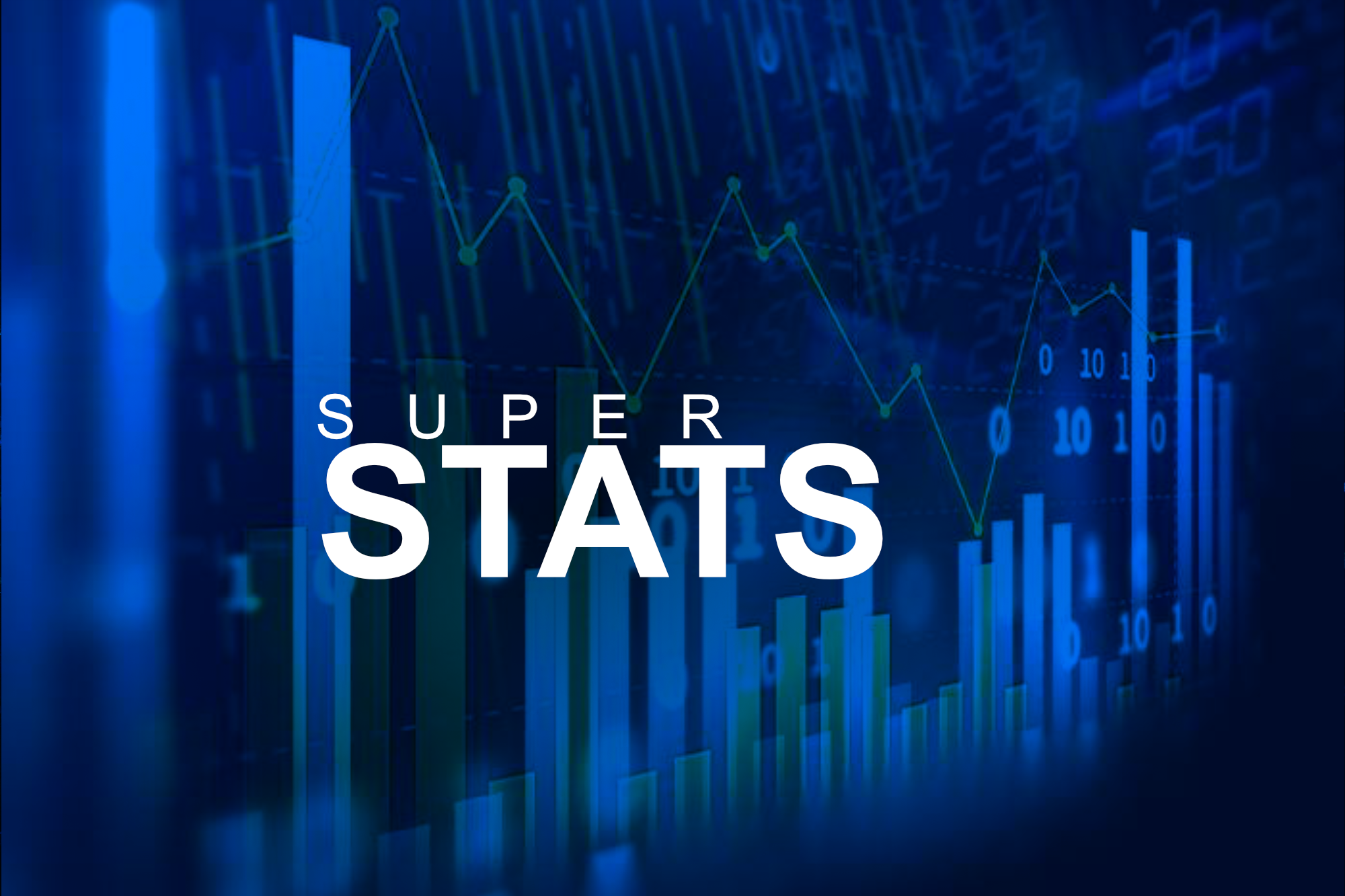Qualifying data for Supercross that’s publicly available dates back to the 2003 season, which gives us 21 seasons worth of data to see various qualifying trends. In the 450 Class, the times have trended closer and closer over the years. This article will be a deep dive on the 450SX qualifying.
Two things to note:
- The AMA data from 2003 through 2006 for qualifying is kind of a mess, so the data from that period might not be perfect but I cleaned it up the best I could
- I removed 2003 Daytona qualifying from 2003’s averages since it is such a crazy outlier, it massively skews the data if included.
450SX Average Qualifying Gaps from First Place Qualifier (2003-2023)
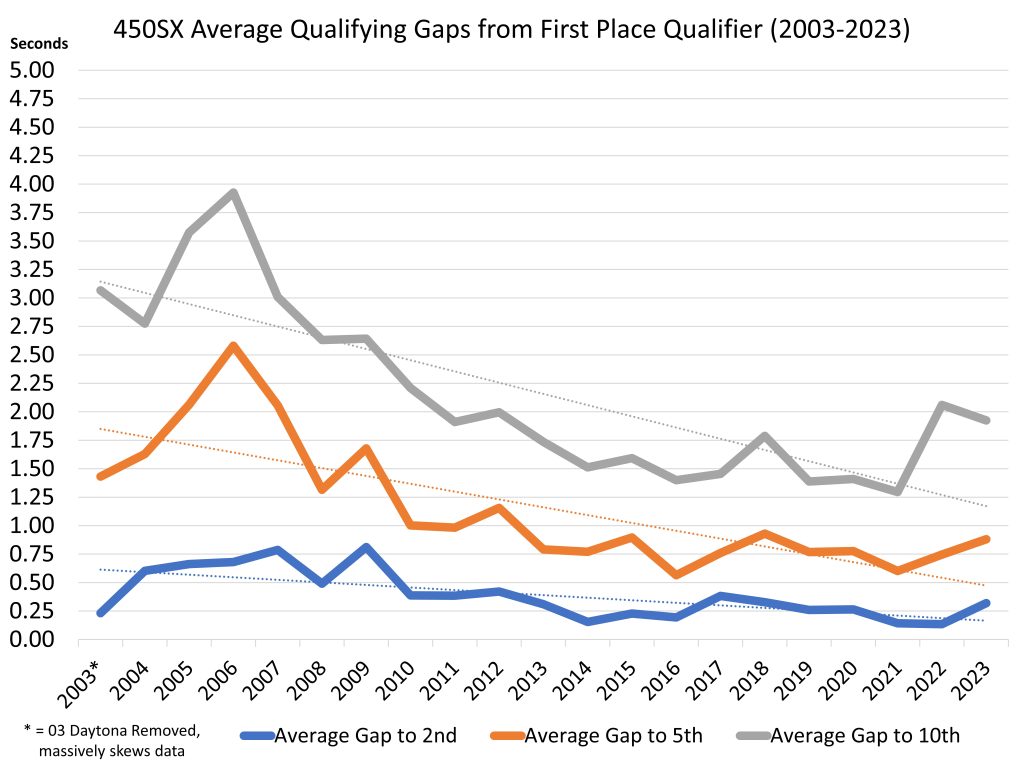
We can still see how the trends have gotten closer over the years.
- We can see a clear jump in the average gaps in the Stewart, Carmichael, Reed years of 2005-2007
- From 2005-2007, Stewart, Carmichael and Reed were the only riders to be on pole with the fastest qualifying lap
- The drop off from 2007 to 2008 and then jump up from 2008 to 2009 is the James Stewart difference. Stewart missed 15 rounds due to injury in 2008, he won the title in both 2007 and 2009.
- Interestingly, there is a clear gap between Stewart/Carmichael/Reed era to the rest of the field. However, this is not as much the case in the championship years of Ryan Villopoto and Ryan Dungey.
- The Ryan’s titles from 2012 through 2016 were fairly dominant, however we see the average gaps getting closer in this time period.
- The spike up in 2022 for the gap to 10th is skewed by one round – Atlanta
- The small jump up in 2023, can be attributed to Chase Sexton. He was fastest qualifier in 14 of 17 rounds.
Here is the same chart but instead of the seconds difference, here is the percentage difference:
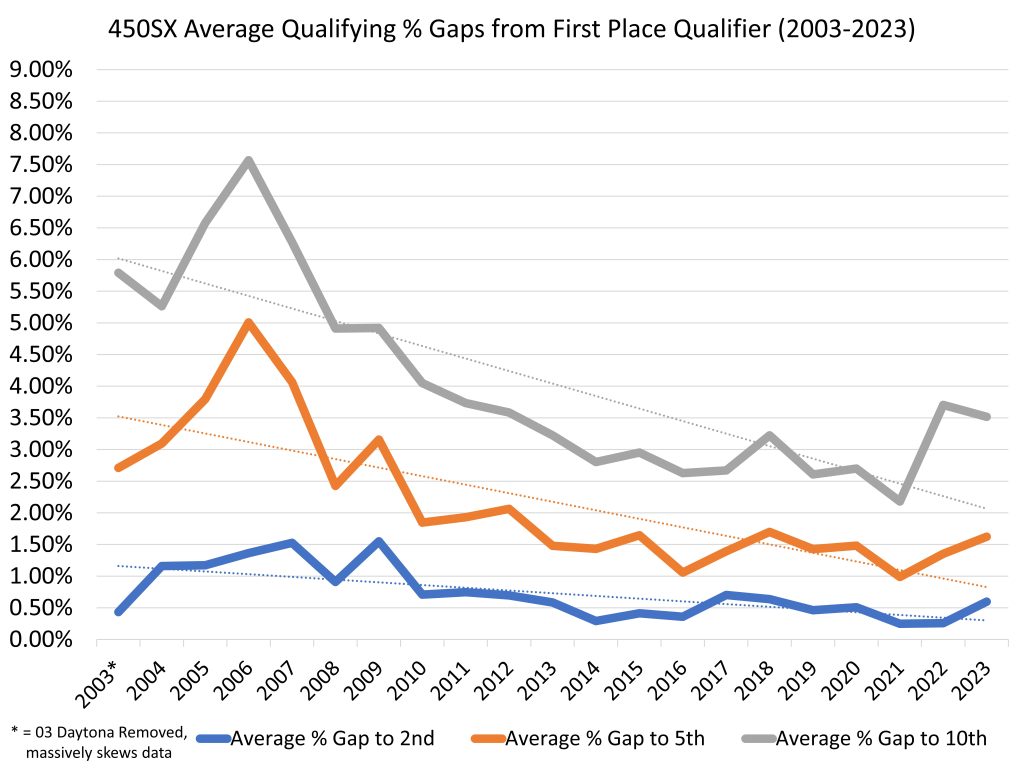
Time vs percentage shows basically the same trends, I’ll use the time difference charts throughout the rest of the article.
This leads to the question of why are the gaps closing? I think this is attributable to several things.
- The bike quality getting continuously better over the years.
- Riding facilities becoming the norm. Other than Tomac, does any factory rider train predominantly alone?
- Training programs, every rider has robust training program.
- Tracks formats
However, these bullet points are also applicable to the 250 class, and yet the 250 class trends have remained relatively flat on both coasts. I only have 250 class data back to 2007. Here are the qualifying trends for the 250 class:
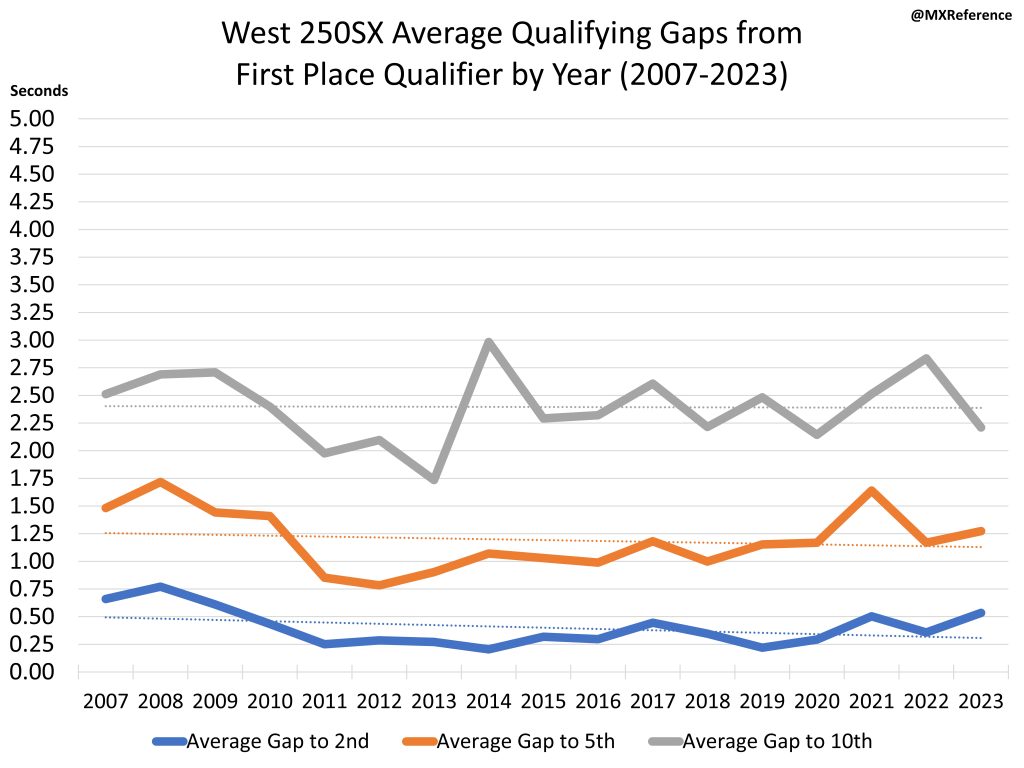
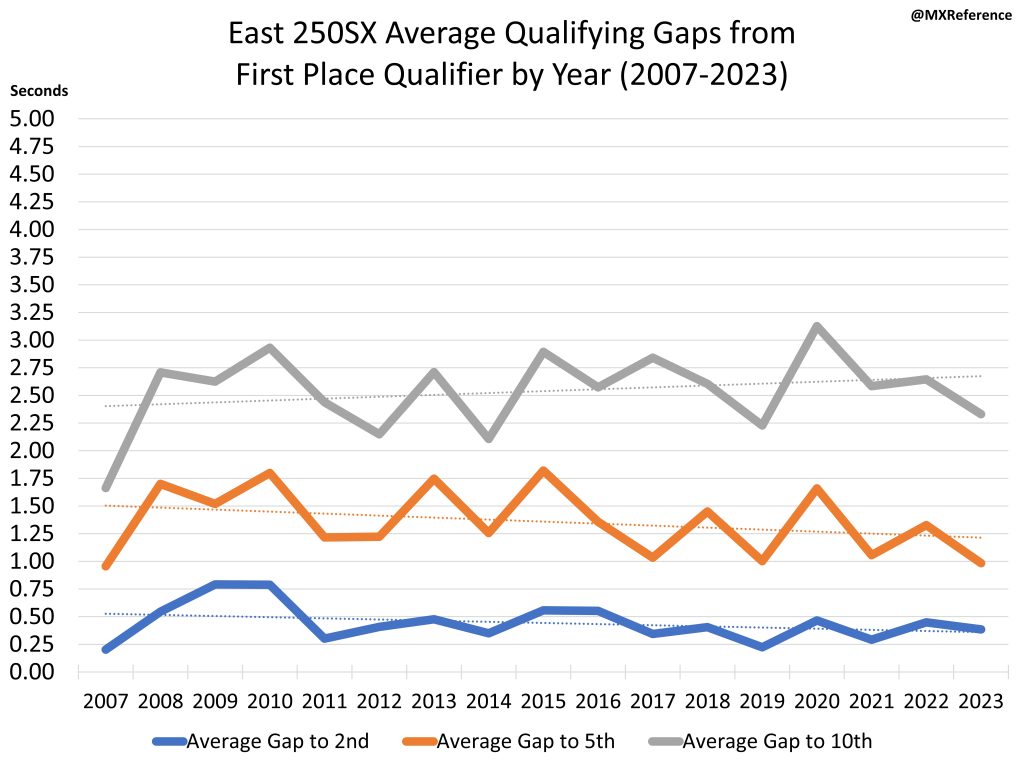
I don’t think you can take away much from the 250 class trends for a few reasons:
- As we can see it is much more volatile than the 450 trends on both coasts
- There is much more turnover in the 250 class with riders coming in and exiting to the 450 class
- The data is cut off at 2007, if this went back to 2003 and included James Stewart’s years, then both coasts would show a an overall downward trend
- Just for fun I looked up the Anaheim 1 2003 qualifying data…Stewart was nearly 1.5 seconds faster than the 2nd place qualifier and 3 seconds faster than the 5th place qualifier
In the 450 class, I also think there is less emphasis on qualifying now. This is somewhat due to the Main Events now being 20 minutes vs just 20 laps. We often see main events get to 27, 28 laps long at times. This breaks down the track and it races much differently than what was ridden earlier in the day during qualifying. Cooper Webb excels at this probably more than anyone. Late in races when the track breaks down is when Webb is at his strongest. And yet Cooper Webb has just 4 pole positions. That is the same number of poles that Blake Baggett had in his Supercross career.
However, this change only took place in 2017. If we adjust the qualifying trends chart to 2017-2023, we actually see a pretty flat trend, and an upward trend for the average gap from 1st to 10th:
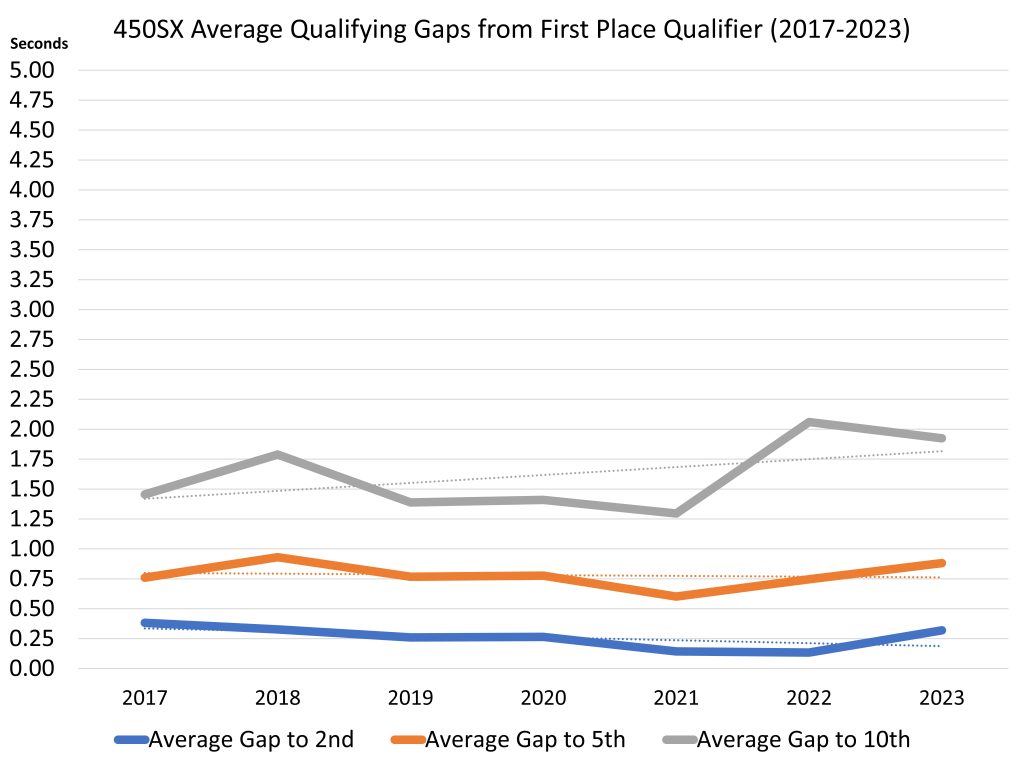
This led me to think that perhaps the downward trend from 2003-2023 can be mainly attributed to the bikes improving and simply the Carmichael, Reed, Stewart dominant era from 2005-2009.
Take a look at the same graph from just 2010-2023:
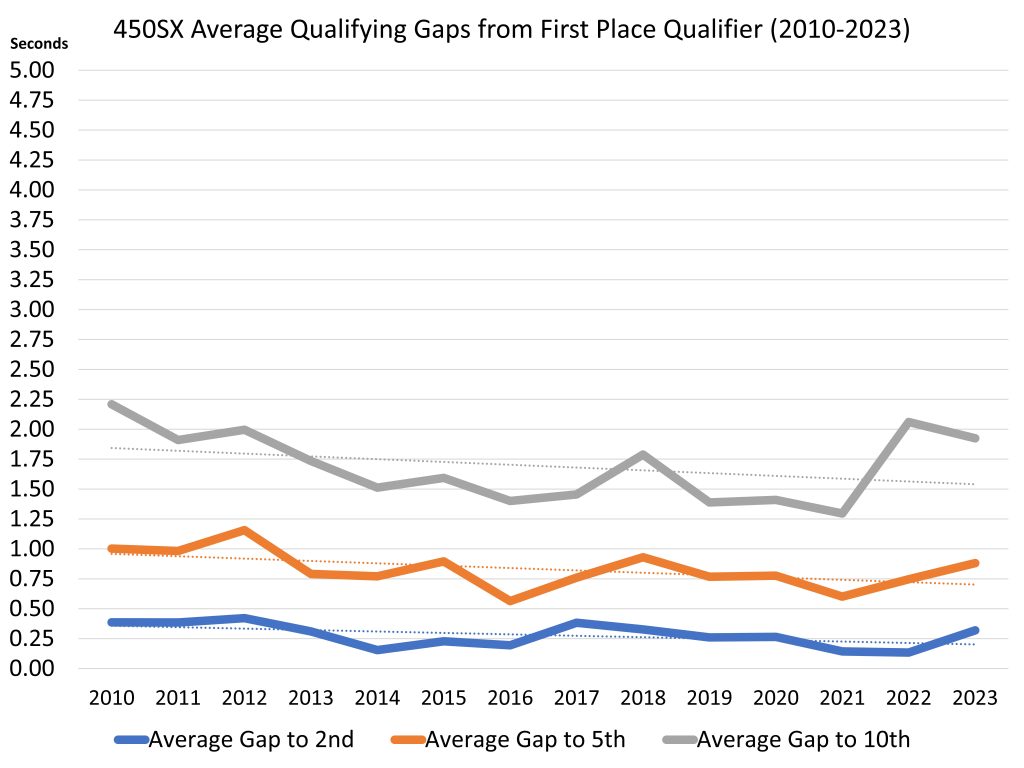
A slight downward trend across the board, but much flatter than when expanded to 2003. The riders are for sure getting closer to each other for nearly 15 years. However, I think the large downward trend we see dating back to 2003 can be largely attributed to RC, Stew and Reed from 2005-2009.
Perhaps going forward we will see it start to trend upwards as we enter the prime Chase Sexton and Jett Lawrence years in the future. It would be great to have data going back further than 2003 to see the McGrath years and before.
Regardless of where the qualifying chart starts or stops, lets look at how successful the riders on pole are.
450SX Pole Position Breakdown
Since 2003, there have been 352 races. Riders with the fastest qualifying lap have:
127 Wins (36.08%)
222 Podiums (63.07%)
262 Top 5s (74.43%)
However, the year-to-year Pole to Win %, Pole to Podium %, Pole to Top 5% have all trended downward:
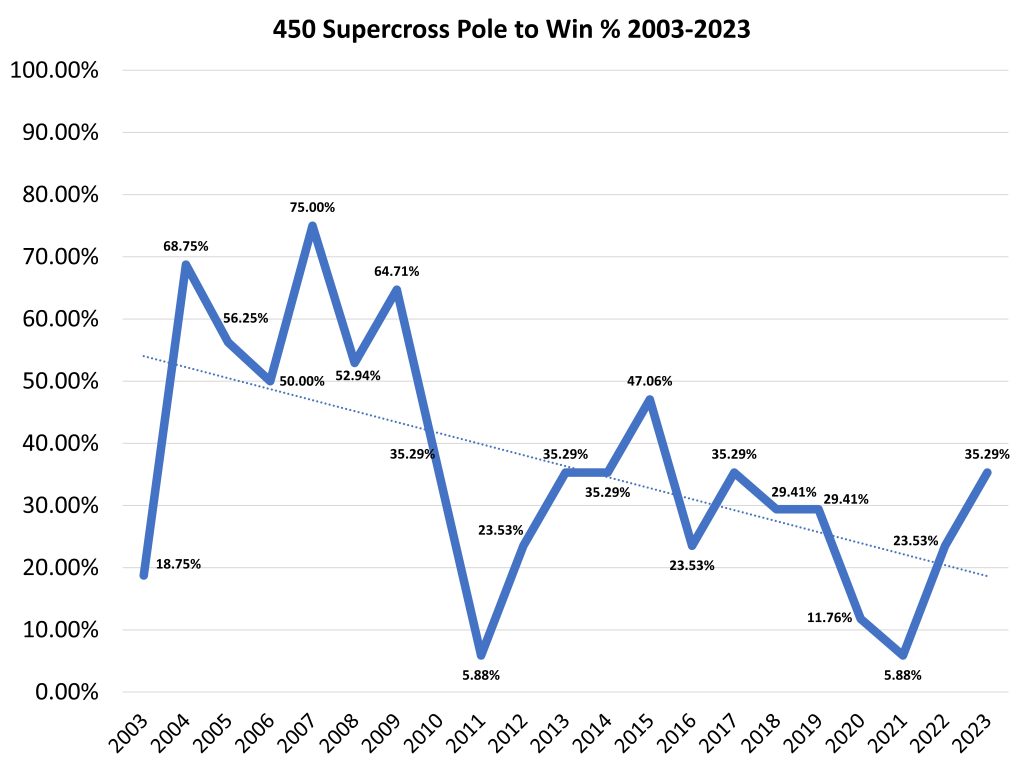
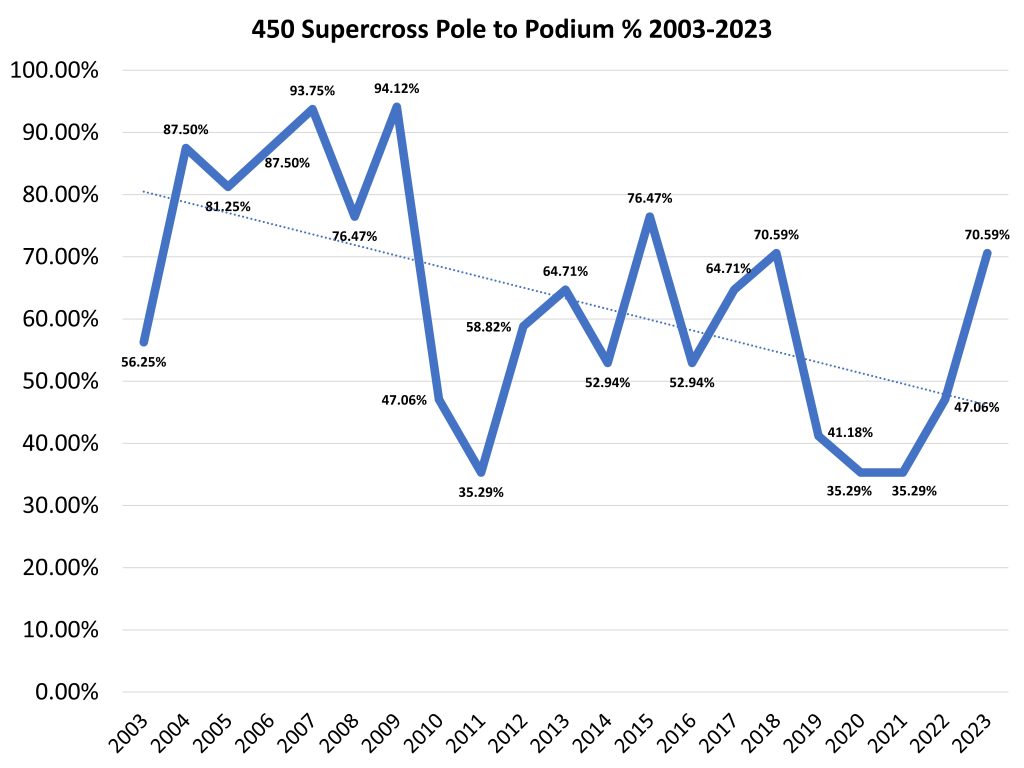
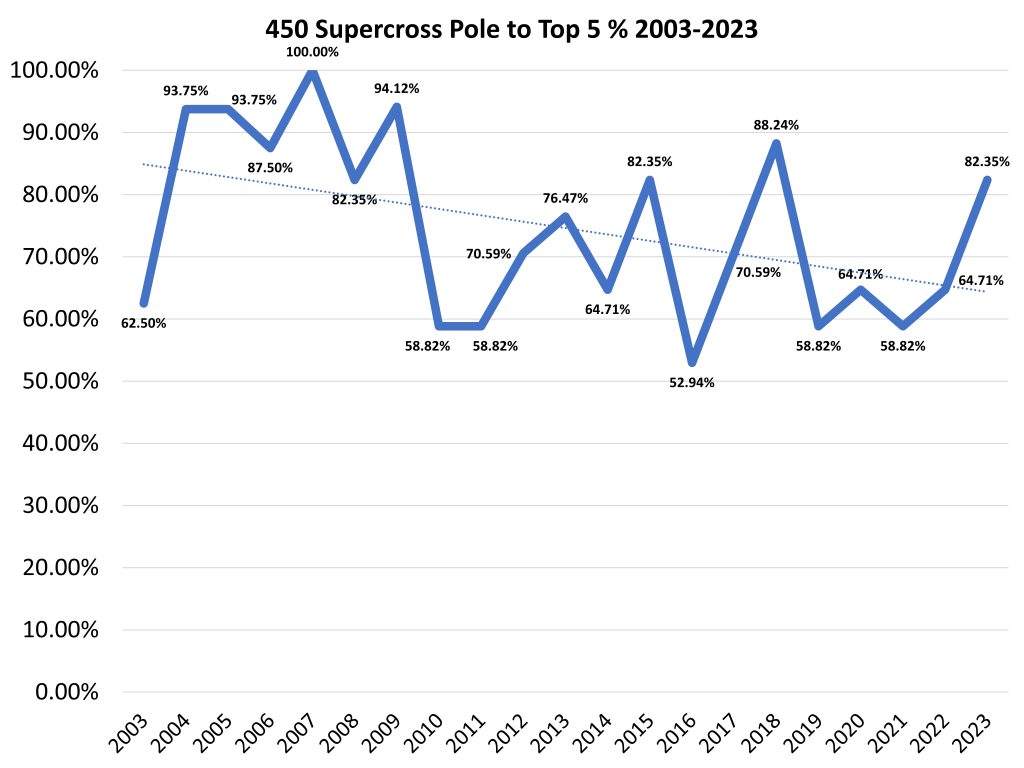
And the average finish for riders on pole has trended worse. This next chart excludes those on pole who didn’t qualify for the main event:
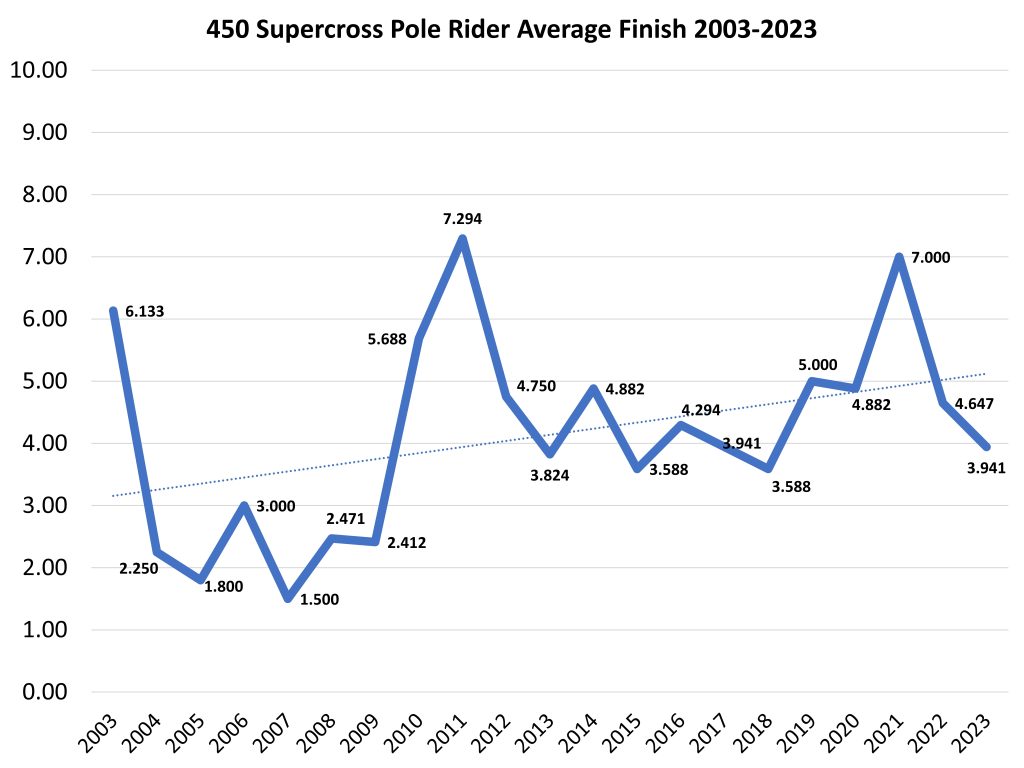
Furthermore, the number of pole positions by champions has trended downwards:
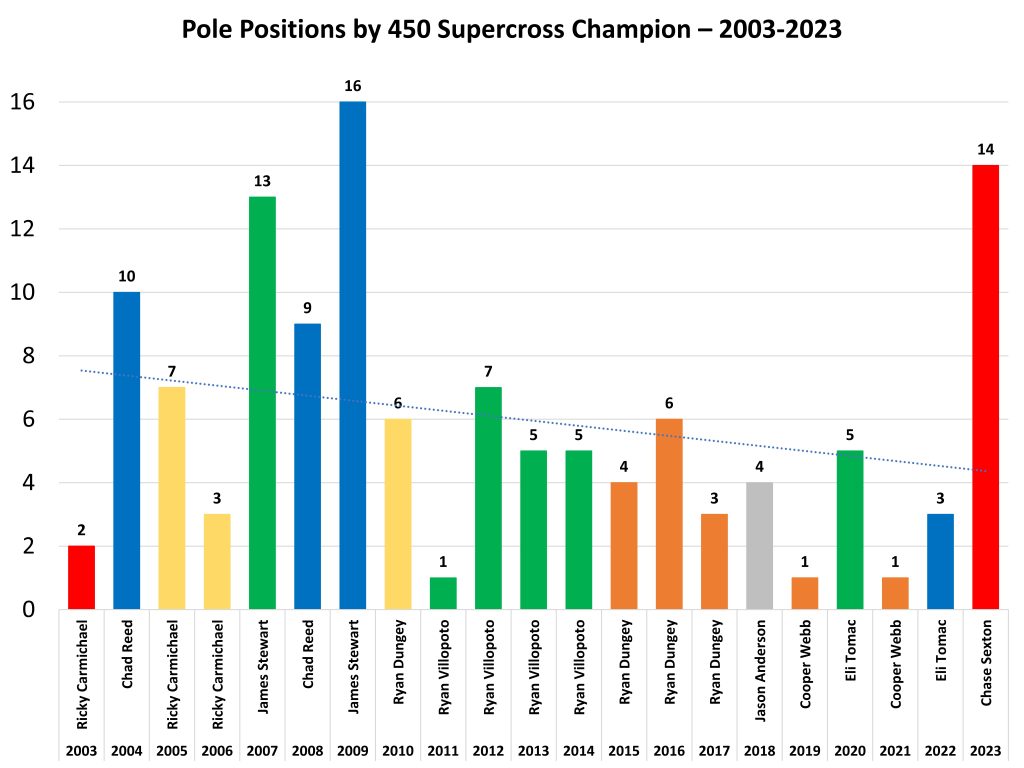
Sexton stands out with his 14 pole positions in 2023. For reference, Eli Tomac and Cooper Webb had zero poles before injury in 2023.
I think Sexton’s 2023 with 14 poles will be a notable outlier going forward with him on a new bike for 2023, Jett coming into the class, and the fact only James Stewart has a higher amount than him in a single year among champions.
Here is a fun stat: in 2009, James Stewart set the fastest lap in qualifying in 16/17 rounds. The only rider to beat him that year? Jason Lawrence at Daytona!
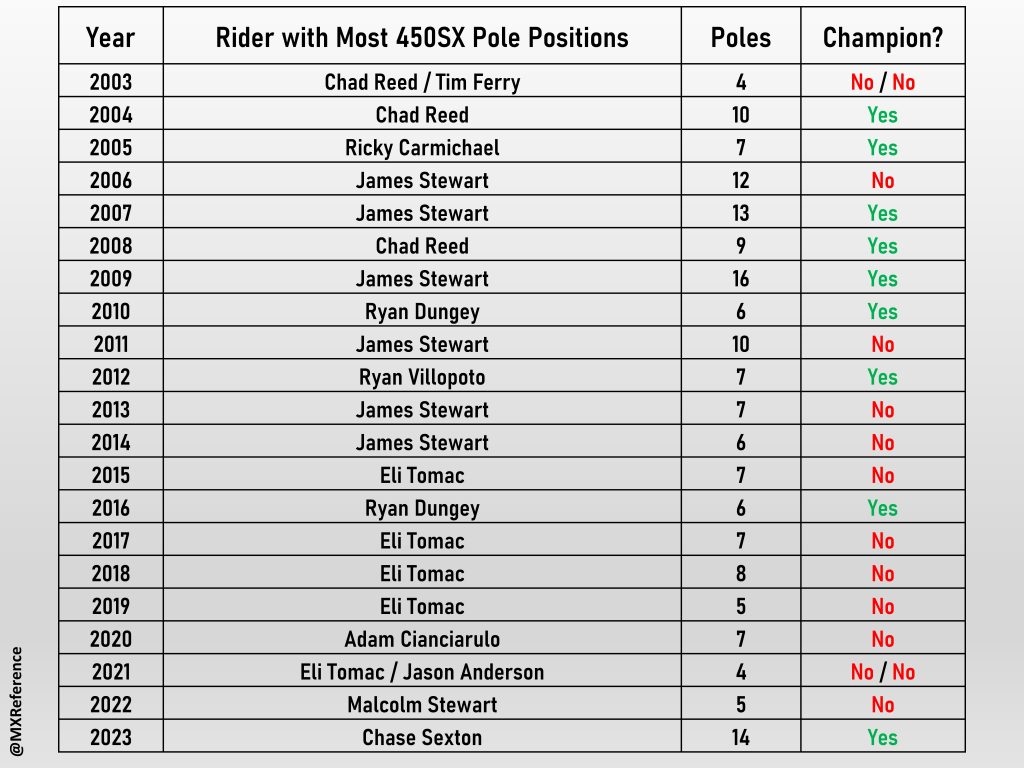
In this table we can see the rider with the most pole positions on the year has only won the title 2 times in the last 10 years.
Adam Cianciarulo was the fastest qualifier for the first 7 rounds in 2020. Since 2003, only James Stewart and Chad Reed have longer consecutive streaks.
We also see the top riders of today with lower career Win to Pole % than previous generations (reminder: this data only goes back to 2003):
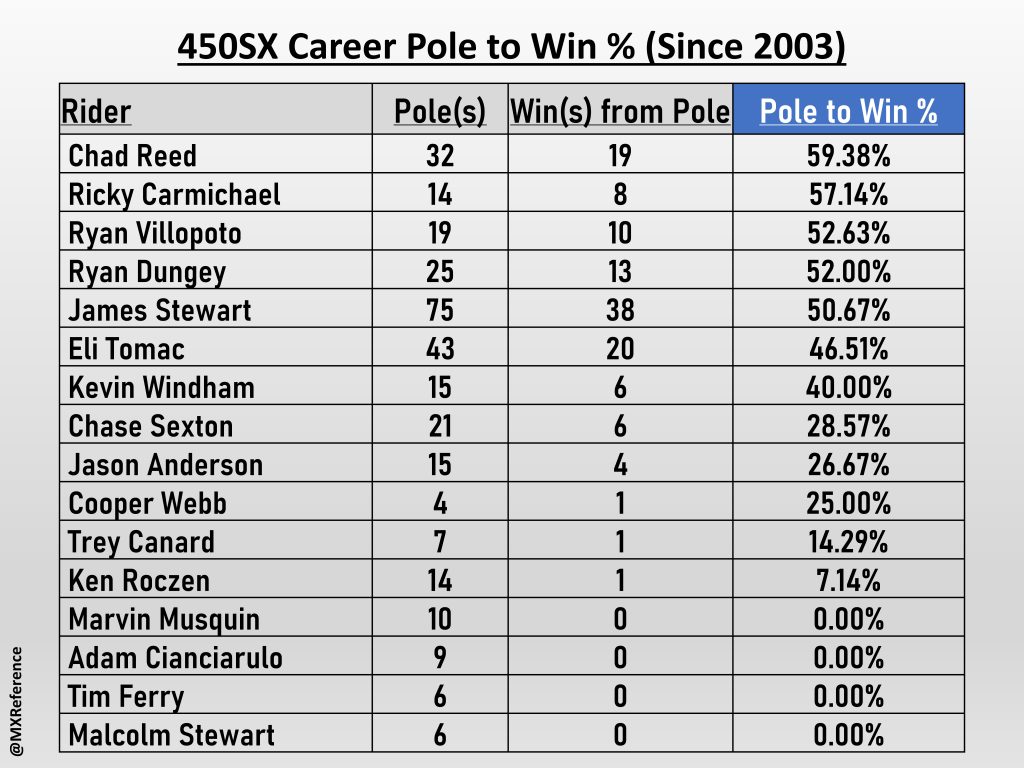 I included some notable riders with with several poles that have not turned any of those poles into wins.
I included some notable riders with with several poles that have not turned any of those poles into wins.
It is interesting that the previous generations of Carmichael, Reed, Stewart, Villopoto and Dungey all have Pole to Win % over 50% and the current generation has much lower percentages (other than Eli Tomac).
- Cooper Webb has never shown crazy, flashy speed, but just 4 career pole positions seems insane for a two time champion with 21 wins.
- Roczen’s overall number of pole positions is lower than I would have thought. And to convert just one pole position into a win is also very surprising as he has 21 career wins.
Thanks for reading! Any questions – hit me up on Twitter or Instagram: @MXReference

